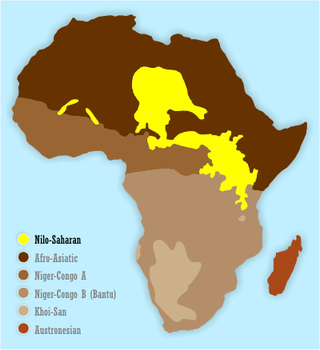Related Research Articles

The Nilo-Saharan languages are a proposed family of African languages spoken by somewhere around 70 million speakers, mainly in the upper parts of the Chari and Nile rivers, including historic Nubia, north of where the two tributaries of the Nile meet. The languages extend through 17 nations in the northern half of Africa: from Algeria to Benin in the west; from Libya to the Democratic Republic of the Congo in the centre; and from Egypt to Tanzania in the east.
Sango is the primary language spoken in the Central African Republic and also the co-official language of the country. It is used as a lingua franca across the country and had 450,000 native speakers in 1988. It also has 1.6 million second language speakers.

The Masalit are an ethnic group inhabiting western Sudan and eastern Chad. They speak the Masalit language.
The Bua languages are a subgroup of the Mbum–Day subgroup of the Savanna languages spoken by fewer than 30,000 people in southern Chad in an area stretching roughly between the Chari River and the Guéra Massif. They were labeled "G13" in Joseph Greenberg's Adamawa language-family proposal. They are ultimately part of the Niger–Congo family, and have exerted a significant influence on Laal.

The Niellim language is a Bua language spoken by some 5,000 people along the Chari River in southern Chad. It is mainly spoken in two areas: one around the city of Sarh and one, its traditional home, further north, between about 9°30′ and 9°50′ N, corresponding to the former chiefdoms of Pra, Niellim, and Niou.
The Adamawa languages are a putative family of 80–90 languages scattered across the Adamawa Plateau in Central Africa, in northern Cameroon, north-western Central African Republic, southern Chad, and eastern Nigeria, spoken altogether by only one and a half million people. Joseph Greenberg classified them as one branch of the Adamawa–Ubangi family of Niger–Congo languages. They are among the least studied languages in Africa, and include many endangered languages; by far the largest is Mumuye, with 400,000 speakers. A couple of unclassified languages—notably Laal and Jalaa—are found along the fringes of the Adamawa area.

The Maban languages are a small family of languages which have been included in the hypothetical Nilo-Saharan stock.

Chad has two official languages, Arabic and French, and over 120 indigenous languages. A vernacular version of Arabic, Chadian Arabic, is a lingua franca and the language of commerce, spoken by 40–60% of the population. The two official languages have fewer speakers than Chadian Arabic. Standard Arabic is spoken by around 615,000 speakers. French is widely spoken in the main cities such as N'Djamena and by most men in the south of the country. Most schooling is in French. The language with the most first-language speakers is probably Ngambay, with around one million speakers.
Kanembu is a Nilo-Saharan language spoken in Chad by the Kanembu people. It is also spoken by a smaller number of people in Niger. It is closely related to Kanuri.
Marba is an Afro-Asiatic language spoken by the Azumeina peoples of Chad as their first language. It is also the name of one of the Azumeina peoples.

Chadian Arabic, also known as Shuwa Arabic, Western Sudanic Arabic, or West Sudanic Arabic (WSA), is a variety of Arabic and the first language of 1.6 million people, both town dwellers and nomadic cattle herders. Most of its speakers live in central and southern Chad. Its range is an east-to-west oval in the Sahel. Nearly all of this territory is within Chad and Sudan. It is also spoken elsewhere in the vicinity of Lake Chad in the countries of Cameroon, Nigeria and Niger. Finally, it is spoken in slivers of the Central African Republic. In addition, this language serves as a lingua franca in much of the region. In most of its range, it is one of several local languages and often not among the major ones.
Zaghawa is a Nilo-Saharan language spoken by the Zaghawa people of east-central Chad and northwestern Sudan (Darfur). The people who speak this language call it Beria, from Beri, the endonym of the Zaghawa people, and a, Zaghawa for "mouth". It has been estimated that there are about 447,400 native speakers of the Zaghawa language, who primarily live in Chad and the Darfur region of Sudan. It is also spoken by a smaller number of speakers in Libya.
Bidiyo is an Afro-Asiatic language spoken in south central Chad.
Mogum or Mogoum is an Afro-Asiatic language spoken in south central Chad. Speakers are found in Sorki canton in Chinguil sub-prefecture.
Sokoro is an Afro-Asiatic language spoken in central Chad. Dialects are Bedanga and Sokoro. Speakers make up the majority of the population of Gogmi Canton in Melfi, Chad.
Mokilko, or Mukulu, is a Chadic language spoken in central Chad. The local name for the language is Gergiko. This is the name used for mother-tongue literacy materials. Mukulu is the name of a village.

The population of Chad has numerous ethnic groups. SIL Ethnologue reports more than 130 distinct languages spoken in Chad.
Koalib is a Niger–Congo language in the Heiban family spoken in the Nuba Mountains of southern Sudan. The Koalib Nuba, Turum and Umm Heitan ethnic groups speak this language.
Marfa is a Maban language spoken in Chad. It is not a dialect of the Masalit language.
References
- 1 2 3 Maba at Ethnologue (27th ed., 2024)

- ↑ "Maba". Ethnologue. Retrieved 8 March 2024.
- ↑ Weiss, Doris (2009). Phonologie et morphosyntaxe du Maba. Université Lumière - Lyon II.
- ↑ Maass, Antje; Mahamat, Abdoulaye Issaakha; Ali, Ousman Timsa; Adam, Duudeen Ali (2017) [2000]. Buraa mabaŋnu jiŋ ger mirni! (Kitab 1) (in Maba) (3 ed.). N’Djaména: SIL Tchad. (PDF dead link)
- ↑ Oumar, Alkassim; Hicham, Fathimat Al-Zahra; Dahab, Abdoulaye Ali; Ali, Ousman Timsa; Zürcher, Evodie; Weiss, Doris (2007) [2000]. بُرَا مَبَݝْنُ، جِݝ قٚر مِرْنِ! (كِتَب ١) (Buraa mabaŋnu jiŋ ger mirni! (Kitab 1)) (in Maba) (4 ed.). N’Djaména: SIL Tchad.
- ↑ Mabaan dictionary (Archive)